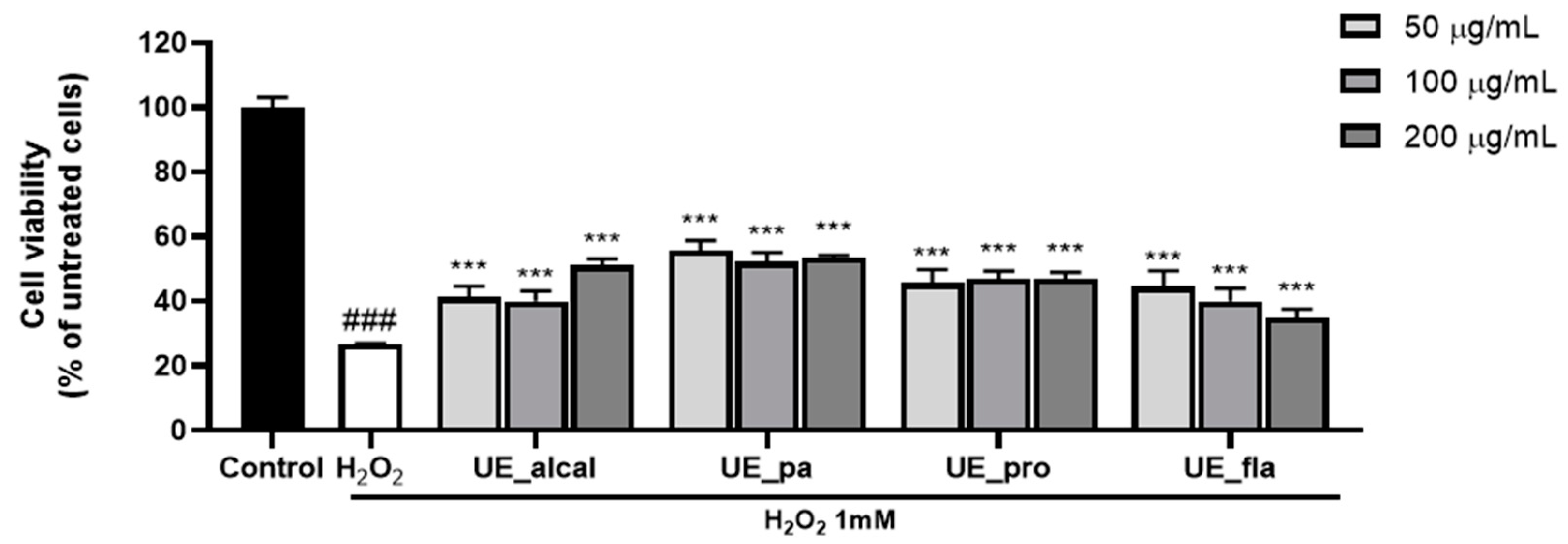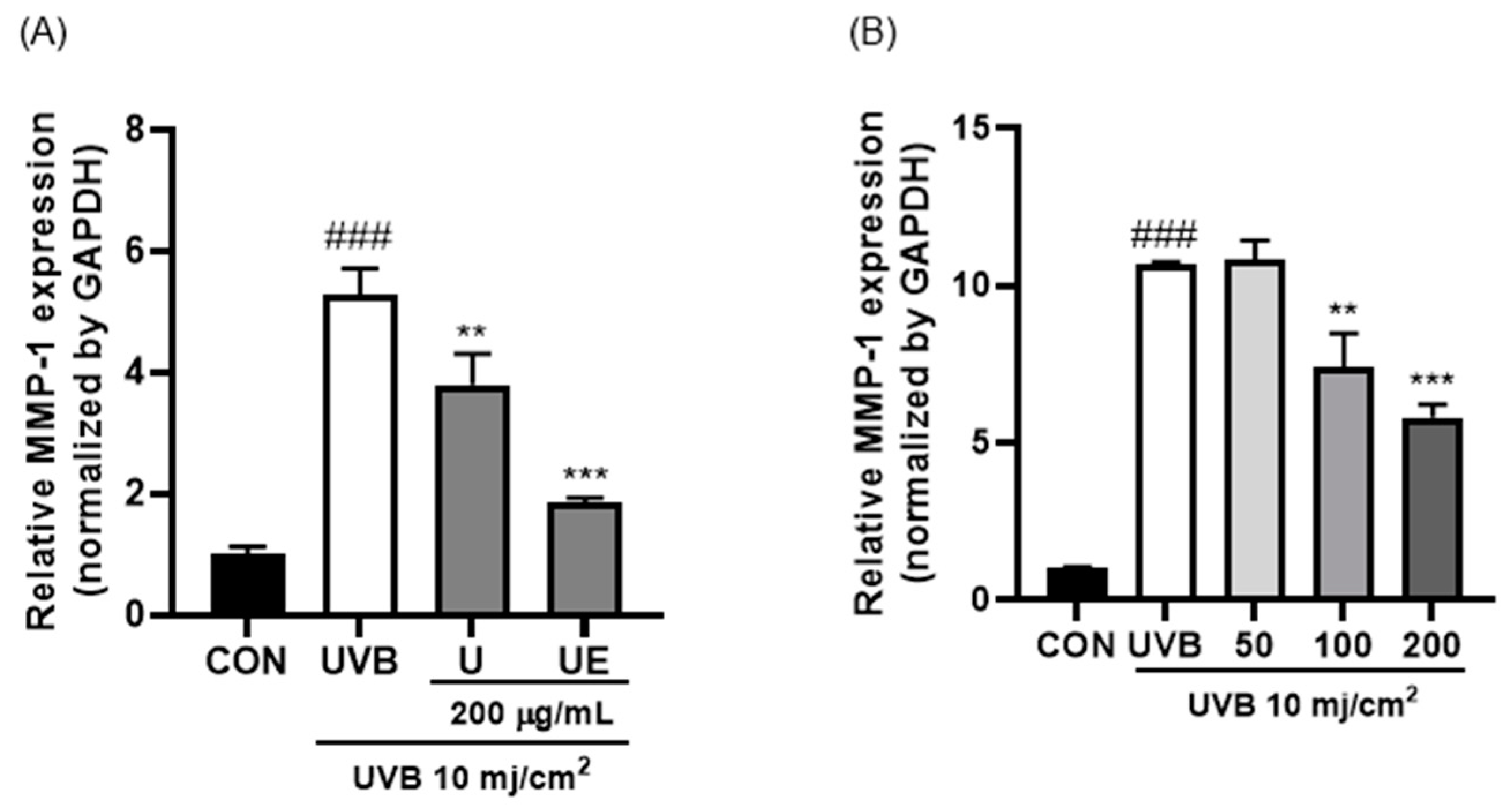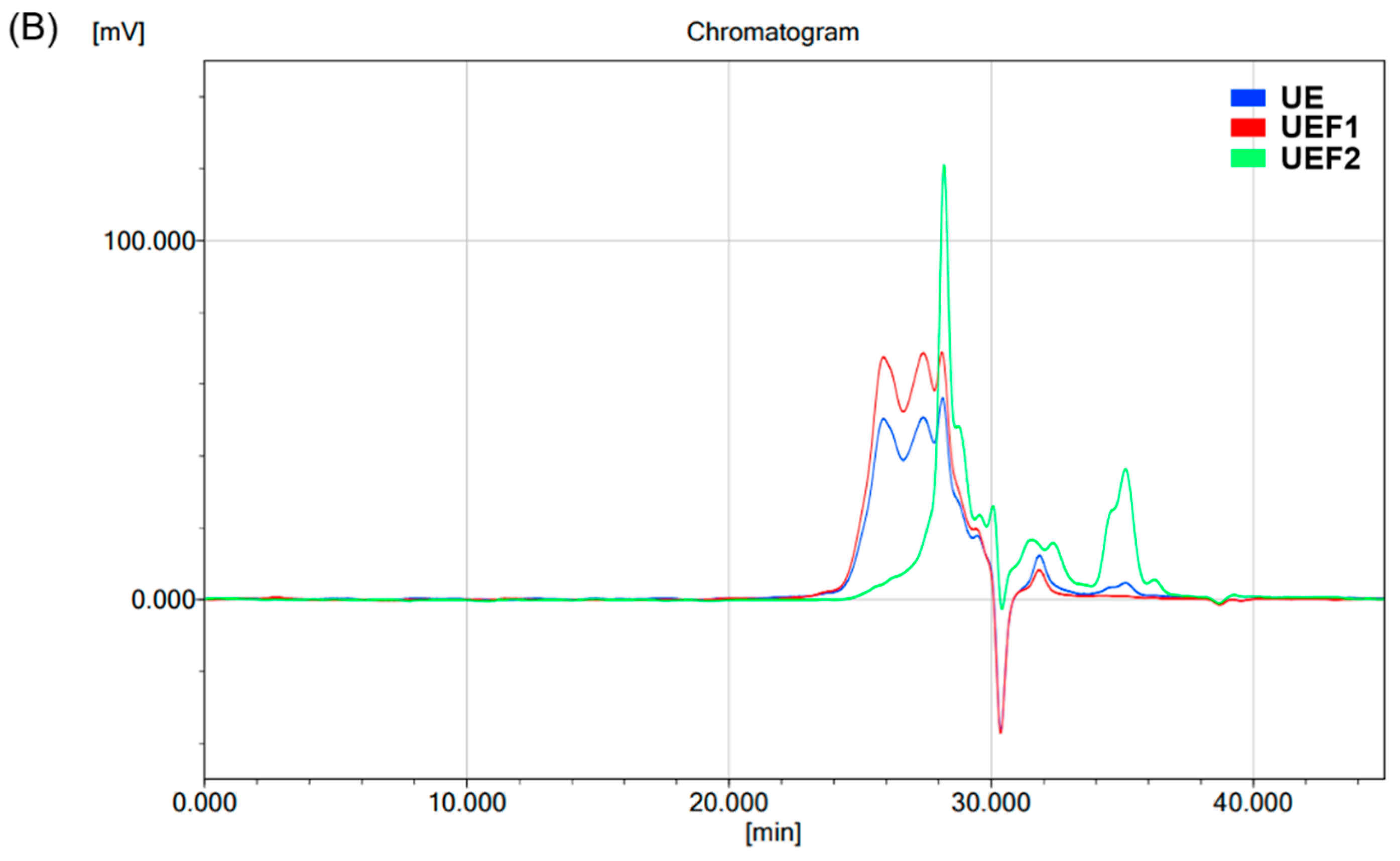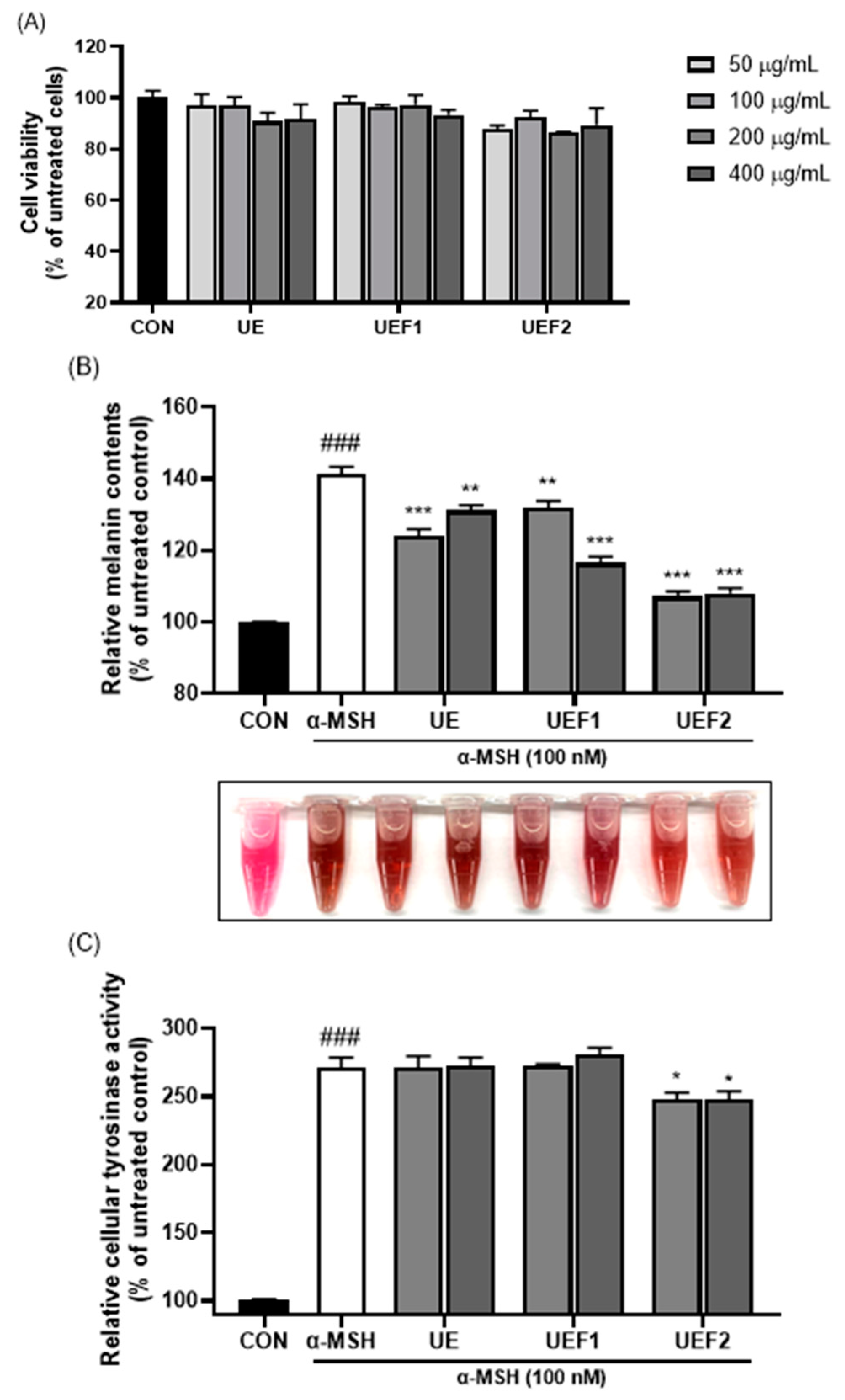Skin Improvement Effects of Ultrasound-Enzyme-Treated Collagen Peptide Extracts from Flatfish (Paralichthys olivaceus) Skin in an In Vitro Model
Abstract
:1. Introduction
2. Results and Discussion
2.1. Ultrasound-Based Collagen Extraction from Flatfish Skin
2.2. Enzyme Treatment of Ultrasonicated Collagen
2.2.1. Enzyme Reaction Condition
2.2.2. Skin Anti-Oxidant Effect of Ultrasound-Enzyme Treated Collagen Peptide
2.2.3. Skin Anti-Wrinkle Effect of Ultrasound-Papain Treated Collagen Peptide
2.3. Isolation of Ultrasound-Papain Treated Collagen Peptide
2.4. Skin Functionality of Ultrasound-Papain Treated Low-Molecular-Weight Collagen Peptide
2.4.1. Anti-Wrinkle Effect
2.4.2. Whitening Effect
3. Materials and Methods
3.1. Ultrasound Treatment for Collagen Extraction from Flatfish (Paralichthys olivaceus) Skin
3.2. Enzyme Treatment of Ultrasound Treated Collagen
3.3. Separation of Ultrasound-Enzyme Treated Collagen
3.4. Analysis of Molecular Weight
3.5. Cell Culture
3.6. Cell Viability
3.7. UVB Irradiation
3.8. Real-Time PCR (qPCR)
3.9. Western Blot
3.10. Melanin Content
3.11. Cellular Tyrosinase Assay
3.12. Statistical Analysis
4. Conclusions
Author Contributions
Funding
Institutional Review Board Statement
Informed Consent Statement
Data Availability Statement
Conflicts of Interest
References
- Jafari, H.; Lista, A.; Siekapen, M.M.; Ghaffari-Bohlouli, P.; Nie, L.; Alimoradi, H.; Shavandi, A. Fish Collagen: Extraction, Characterization, and Applications for Biomaterials Engineering. Polymers 2020, 12, 2230. [Google Scholar] [CrossRef] [PubMed]
- Rajabimashhadi, Z.; Gallo, N.; Salvatore, L.; Lionetto, F. Collagen Derived from Fish Industry Waste: Progresses and Challenges. Polymers 2023, 15, 544. [Google Scholar] [CrossRef]
- Avila Rodríguez, M.I.; Rodríguez Barroso, L.G.; Sánchez, M.L. Collagen: A review on its sources and potential cosmetic applications. J. Cosmet. Dermatol. 2018, 17, 20–26. [Google Scholar] [CrossRef]
- Rezvani Ghomi, E.; Nourbakhsh, N.; Akbari Kenari, M.; Zare, M.; Ramakrishna, S. Collagen-based biomaterials for biomedical applications. J. Biomed. Mater. Res. Part B Appl. Biomater. 2021, 109, 1986–1999. [Google Scholar] [CrossRef]
- Lu, W.-C.; Chiu, C.-S.; Chan, Y.-J.; Mulio, A.T.; Li, P.-H. Characterization and biological properties of marine by-product collagen through ultrasound-assisted extraction. Aquac. Rep. 2023, 29, 101514. [Google Scholar] [CrossRef]
- Matinong, A.M.E.; Chisti, Y.; Pickering, K.L.; Haverkamp, R.G. Collagen Extraction from Animal Skin. Biology 2022, 11, 905. [Google Scholar] [CrossRef] [PubMed]
- Petcharat, T.; Benjakul, S.; Karnjanapratum, S.; Nalinanon, S. Ultrasound-assisted extraction of collagen from clown featherback (Chitala ornata) skin: Yield and molecular characteristics. J. Sci. Food Agric. 2021, 101, 648–658. [Google Scholar] [CrossRef] [PubMed]
- Gómez-Guillén, M.C.; Giménez, B.; López-Caballero, M.E.; Montero, M.P. Functional and bioactive properties of collagen and gelatin from alternative sources: A review. Food Hydrocoll. 2011, 25, 1813–1827. [Google Scholar] [CrossRef]
- Harris, M.; Potgieter, J.; Ishfaq, K.; Shahzad, M. Developments for Collagen Hydrolysate in Biological, Biochemical, and Biomedical Domains: A Comprehensive Review. Materials 2021, 14, 2806. [Google Scholar] [CrossRef]
- Li, B. Beneficial Effects of Collagen Hydrolysate: A Review on Recent Developments. Biomed. J. Sci. Tech. Res. 2017, 1, 458–461. [Google Scholar] [CrossRef]
- Zhao, X.; Zhang, X.; Liu, D. Collagen peptides and the related synthetic peptides: A review on improving skin health. J. Funct. Foods 2021, 86, 104680. [Google Scholar] [CrossRef]
- Song, K.-M.; Jung, S.K.; Kim, Y.H.; Kim, Y.E.; Lee, N.H. Development of industrial ultrasound system for mass production of collagen and biochemical characteristics of extracted collagen. Food Bioprod. Process. 2018, 110, 96–103. [Google Scholar] [CrossRef]
- Wang, H. A Review of the Effects of Collagen Treatment in Clinical Studies. Polymers 2021, 13, 3868. [Google Scholar] [CrossRef] [PubMed]
- Hu, W.; Zhang, J.; Wang, H.; Guan, M.; Dai, L.; Li, J.; Kang, X. Protective effects of isorhamnetin against H2O2-induced oxidative damage in HaCaT cells and comprehensive analysis of key genes. Sci. Rep. 2023, 13, 2498. [Google Scholar] [CrossRef]
- Zhang, J.; Wang, W.; Mao, X. Chitopentaose protects HaCaT cells against H2O2-induced oxidative damage through modulating MAPKs and Nrf2/ARE signaling pathways. J. Funct. Foods 2020, 72, 104086. [Google Scholar] [CrossRef]
- Ermis, E. Halal status of enzymes used in food industry. Trends Food Sci. Technol. 2017, 64, 69–73. [Google Scholar] [CrossRef]
- Raveendran, S.; Parameswaran, B.; Ummalyma, S.B.; Abraham, A.; Mathew, A.K.; Madhavan, A.; Rebello, S.; Pandey, A. Applications of Microbial Enzymes in Food Industry. Food Technol. Biotechnol. 2018, 56, 16–30. [Google Scholar] [CrossRef]
- Binkley, K.E. Allergy to supplemental lactase enzyme. J. Allergy Clin. Immunol. 1996, 97, 1414–1416. [Google Scholar] [CrossRef]
- Ramli, A.R.; Annisa, A.R.; Bahmid, N.A.; Mustafa, M.D. Isolation of papain-soluble collagen from the skin of snake-head fish (Channa striata). Canrea J. Food Technol. Nutr. Culin. J. 2020, 3, 87–93. [Google Scholar] [CrossRef]
- Nurhayati, T.; Nurjanah; Astiana, I. Characteristics of papain soluble collagen from redbelly yellowtail fusilier (Caesio cuning). IOP Conf. Ser. Earth Environ. Sci. 2018, 196, 012034. [Google Scholar] [CrossRef]
- Dhakal, D.; Koomsap, P.; Lamichhane, A.; Sadiq, M.B.; Anal, A.K. Optimization of collagen extraction from chicken feet by papain hydrolysis and synthesis of chicken feet collagen based biopolymeric fibres. Food Biosci. 2018, 23, 23–30. [Google Scholar] [CrossRef]
- Chen, X.; Xia, P.; Zheng, S.; Li, Y.; Fang, J.; Ma, Z.; Zhang, L.; Zhang, X.; Hao, L.; Zhang, H. Antioxidant Peptides from the Collagen of Antler Ossified Tissue and Their Protective Effects against H2O2-Induced Oxidative Damage toward HaCaT Cells. Molecules 2023, 28, 6887. [Google Scholar] [CrossRef]
- Chotphruethipong, L.; Sukketsiri, W.; Battino, M.; Benjakul, S. Conjugate between hydrolyzed collagen from defatted seabass skin and epigallocatechin gallate (EGCG): Characteristics, antioxidant activity and in vitro cellular bioactivity. RSC Adv. 2021, 11, 2175–2184. [Google Scholar] [CrossRef]
- D’Orazio, J.; Jarrett, S.; Amaro-Ortiz, A.; Scott, T. UV radiation and the skin. Int. J. Mol. Sci. 2013, 14, 12222–12248. [Google Scholar] [CrossRef]
- Buechner, N.; Schroeder, P.; Jakob, S.; Kunze, K.; Maresch, T.; Calles, C.; Krutmann, J.; Haendeler, J. Changes of MMP-1 and collagen type Iα1 by UVA, UVB and IRA are differentially regulated by Trx-1. Exp. Gerontol. 2008, 43, 633–637. [Google Scholar] [CrossRef] [PubMed]
- Sim, W.J.; Kim, J.; Baek, K.S.; Lim, W.; Lim, T.G. Porcine Placenta Peptide Inhibits UVB-Induced Skin Wrinkle Formation and Dehydration: Insights into MAPK Signaling Pathways from In Vitro and In Vivo Studies. Int. J. Mol. Sci. 2023, 25, 83. [Google Scholar] [CrossRef]
- Bang, J.S.; Choung, S.-Y. Inhibitory effect of oyster hydrolysate on wrinkle formation against UVB irradiation in human dermal fibroblast via MAPK/AP-1 and TGFβ/Smad pathway. J. Photochem. Photobiol. B Biol. 2020, 209, 111946. [Google Scholar] [CrossRef]
- Cho, C.H.; Lim, W.; Sim, W.J.; Lim, T.G. Oral administration of collagen peptide in SKH-1 mice suppress UVB-induced wrinkle and dehydration through MAPK and MAPKK signaling pathways, in vitro and in vivo evidence. Food Sci. Biotechnol. 2024, 33, 955–967. [Google Scholar] [CrossRef]
- Chan, Y.Y.; Kim, K.H.; Cheah, S.H. Inhibitory effects of Sargassum polycystum on tyrosinase activity and melanin formation in B16F10 murine melanoma cells. J. Ethnopharmacol. 2011, 137, 1183–1188. [Google Scholar] [CrossRef] [PubMed]
- Xin, X.J.; Zou, J.; Zou, T.; Shang, H.; Sun, L.Y. A Newly Authenticated Compound from Traditional Chinese Medicine Decoction Induces Melanogenesis in B16-F10 Cells by Increasing Tyrosinase Activity. Evid.-Based Complement. Altern. Med. 2018, 2018, 8485670. [Google Scholar] [CrossRef]
- Benjakul, S.; Karnjanapratum, S.; Visessanguan, W. Production and Characterization of Odorless Antioxidative Hydrolyzed Collagen from Seabass (Lates calcarifer) Skin Without Descaling. Waste Biomass Valorization 2017, 9, 549–559. [Google Scholar] [CrossRef]
- Hu, Z.; Yang, P.; Zhou, C.; Li, S.; Hong, P. Marine Collagen Peptides from the Skin of Nile Tilapia (Oreochromis niloticus): Characterization and Wound Healing Evaluation. Mar. Drugs 2017, 15, 102. [Google Scholar] [CrossRef] [PubMed]
- Kumar, P.; Nagarajan, A.; Uchil, P.D. Analysis of Cell Viability by the MTT Assay. Cold Spring Harb. Protoc. 2018, 2018, pdb-prot095505. [Google Scholar] [CrossRef]







| UE | UEF1 | UEF2 | |
|---|---|---|---|
| Number Average Molecular weight (Mn, Da) | 619 | 650 | 360 |
| Weight Average Molecular weight (Mw, Da) | 1095 | 1100 | 468 |
| Z Average Molecular weight (Mz, Da) | 2824 | 2202 | 710 |
Disclaimer/Publisher’s Note: The statements, opinions and data contained in all publications are solely those of the individual author(s) and contributor(s) and not of MDPI and/or the editor(s). MDPI and/or the editor(s) disclaim responsibility for any injury to people or property resulting from any ideas, methods, instructions or products referred to in the content. |
© 2024 by the authors. Licensee MDPI, Basel, Switzerland. This article is an open access article distributed under the terms and conditions of the Creative Commons Attribution (CC BY) license (https://creativecommons.org/licenses/by/4.0/).
Share and Cite
Eom, S.-J.; Kim, J.-H.; Ryu, A.-R.; Park, H.; Lee, J.-H.; Park, J.-H.; Lee, N.-H.; Lee, S.; Lim, T.-G.; Kang, M.-C.; et al. Skin Improvement Effects of Ultrasound-Enzyme-Treated Collagen Peptide Extracts from Flatfish (Paralichthys olivaceus) Skin in an In Vitro Model. Int. J. Mol. Sci. 2024, 25, 9300. https://doi.org/10.3390/ijms25179300
Eom S-J, Kim J-H, Ryu A-R, Park H, Lee J-H, Park J-H, Lee N-H, Lee S, Lim T-G, Kang M-C, et al. Skin Improvement Effects of Ultrasound-Enzyme-Treated Collagen Peptide Extracts from Flatfish (Paralichthys olivaceus) Skin in an In Vitro Model. International Journal of Molecular Sciences. 2024; 25(17):9300. https://doi.org/10.3390/ijms25179300
Chicago/Turabian StyleEom, Su-Jin, Jae-Hoon Kim, A-Reum Ryu, Heejin Park, Jae-Hoon Lee, Jung-Hyun Park, Nam-Hyouck Lee, Saerom Lee, Tae-Gyu Lim, Min-Cheol Kang, and et al. 2024. "Skin Improvement Effects of Ultrasound-Enzyme-Treated Collagen Peptide Extracts from Flatfish (Paralichthys olivaceus) Skin in an In Vitro Model" International Journal of Molecular Sciences 25, no. 17: 9300. https://doi.org/10.3390/ijms25179300






